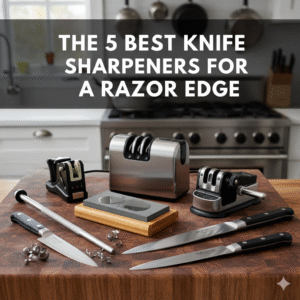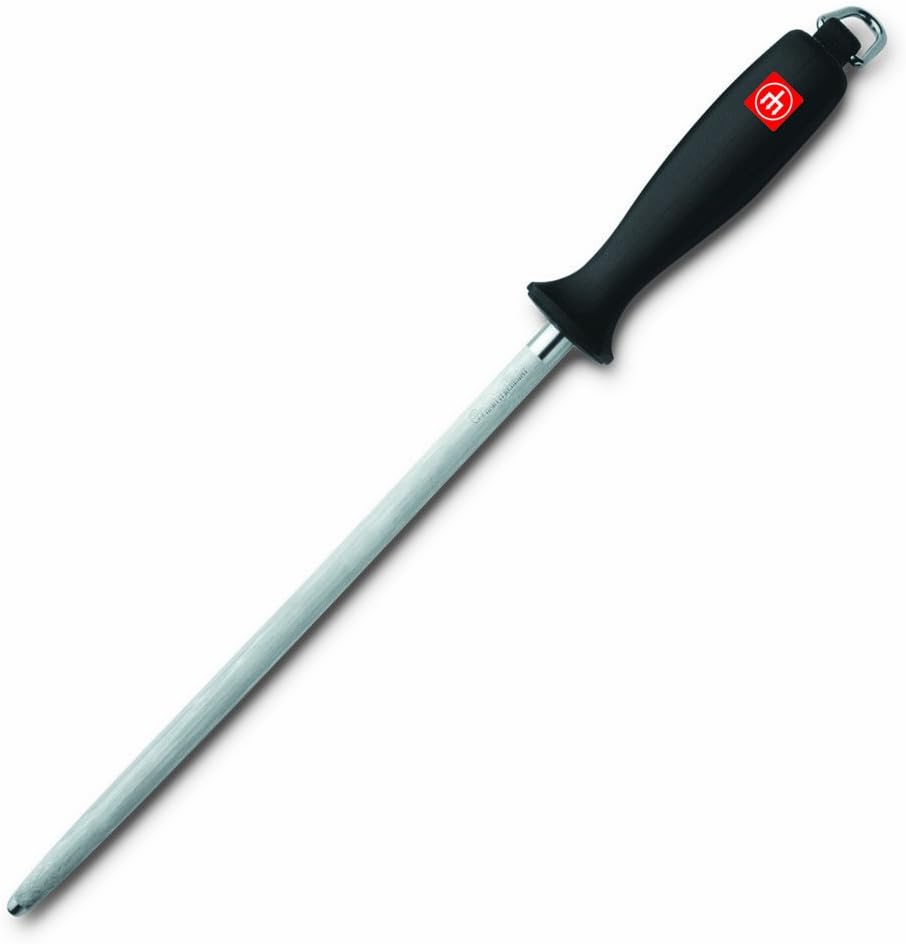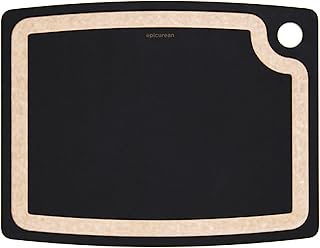From Dull to Dazzling: The 5 Best Knife Sharpeners for a Razor Edge in 2025
A dull knife is more than just an inconvenience—it’s a dangerous and inefficient tool. It crushes delicate herbs, slips off tomato skins, and requires you to use excessive force, increasing the risk of an accident. The secret to a lifetime of effortless cutting isn’t buying a new knife every year; it’s owning a great knife sharpener. This is the tool that transforms your tired, worn-out blades back into the precision instruments they were meant to be.
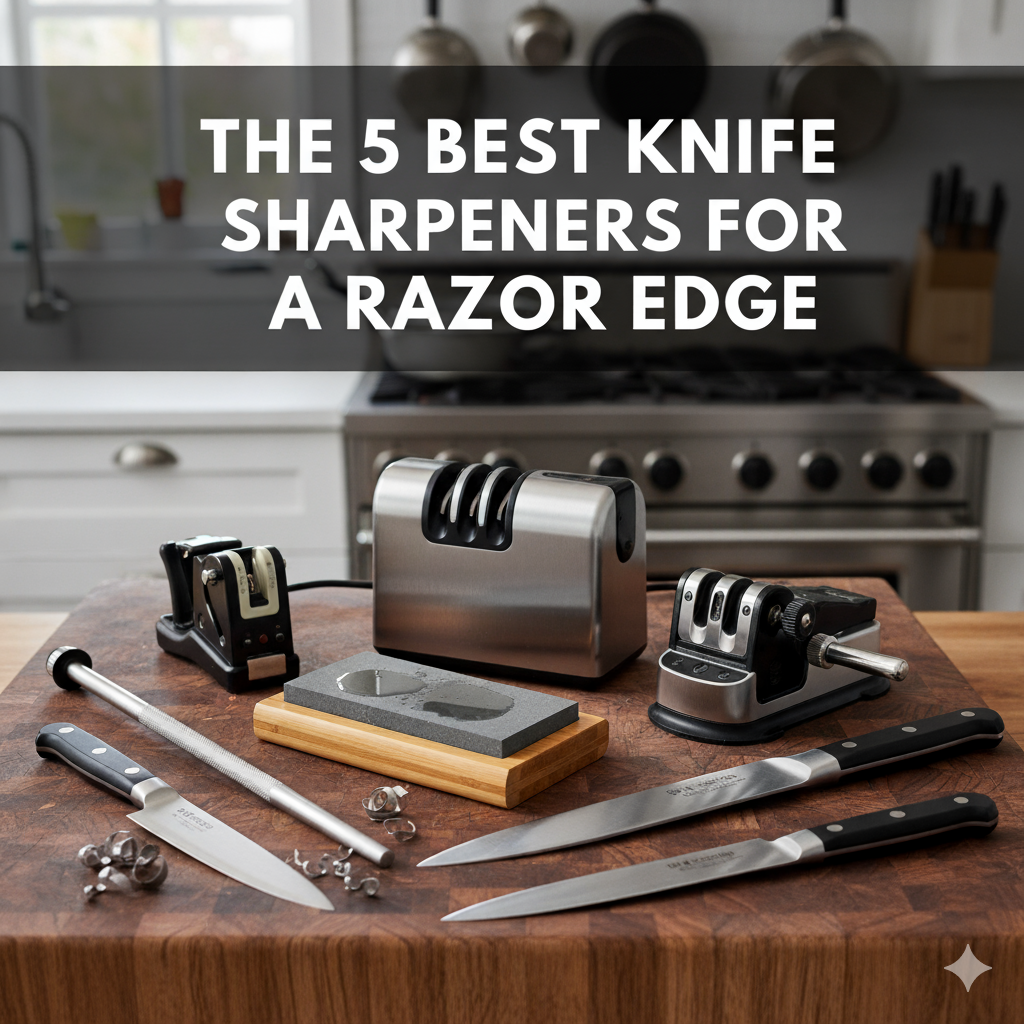
The Tomato Test: My Wake-Up Call to Sharpness
I used to be one of those people who thought honing my knife was the same as sharpening it. I’d dutifully run my chef’s knife over the steel rod that came with my block set, assuming I was doing the right thing. But over time, my knife got progressively worse. The final straw was what I call “The Tomato Test.” I was trying to slice a beautiful heirloom tomato, and instead of cutting through the skin, my knife just skidded off and squashed it into a pulpy mess. It was infuriating.
That evening, I took my knife to a friend who is a professional chef. He took one look at the blade and chuckled. He explained the crucial difference between honing (re-aligning an edge) and sharpening (creating a new one). He sat me down with a whetstone, and over the next 30 minutes, he taught me how to properly grind a new edge. The first slice I made with my newly sharpened knife was a revelation. It glided through a piece of paper. It created transparently thin slices of that same tomato. Since that day, I’ve become obsessed with the art and science of sharpening, testing every type of device to find the most effective and user-friendly options for the home cook.
The Cutting Edge: Our Criteria for Selecting the Best Sharpeners
Choosing a knife sharpener can be intimidating, with a huge range of types and prices. We focused on the key performance indicators that deliver a consistently sharp, durable edge without damaging your valuable knives. Every sharpener on this list was evaluated against these rigorous standards.
Our Core Sharpening Philosophy: A great sharpener should be effective, easy to use, and above all, safe for your knives. It should give you confidence, not make you nervous about ruining your favorite blade.
- Effectiveness & Quality of Edge: How sharp does it get the knife? We tested the final edge on paper, ripe tomatoes, and onions. We looked for a sharp, smooth, and consistent edge from heel to tip.
- Ease of Use: Can a beginner use it safely and get good results? We prioritized systems with clear instructions, built-in angle guides, and a straightforward process. Whetstones require skill, but we selected a kit that is very beginner-friendly.
- Angle Control: The sharpening angle is critical for performance. We favored sharpeners that offer precise angle control (like 15° for Asian knives and 20° for Western knives) or are designed for one of these common angles.
- Abrasive Material: The sharpening material matters. We looked for high-quality abrasives like diamond, ceramic, and tungsten carbide, which sharpen efficiently without being overly aggressive.
- Safety & Knife Care: A sharpener must not harm the knife. We looked for features that protect the blade, such as flexible abrasive belts or fine-grit polishing stages. We also assessed the safety of the device for the user (e.g., non-slip bases, handguards).
Quick Picks: The Best Knife Sharpeners of 2025
Don’t have time to read the details? Here are our top 5 sharpeners, each a winner in its category.
| Sharpener | Image | Type | Best For | Check on Amazon |
|---|---|---|---|---|
| Chef’sChoice Trizor XV | 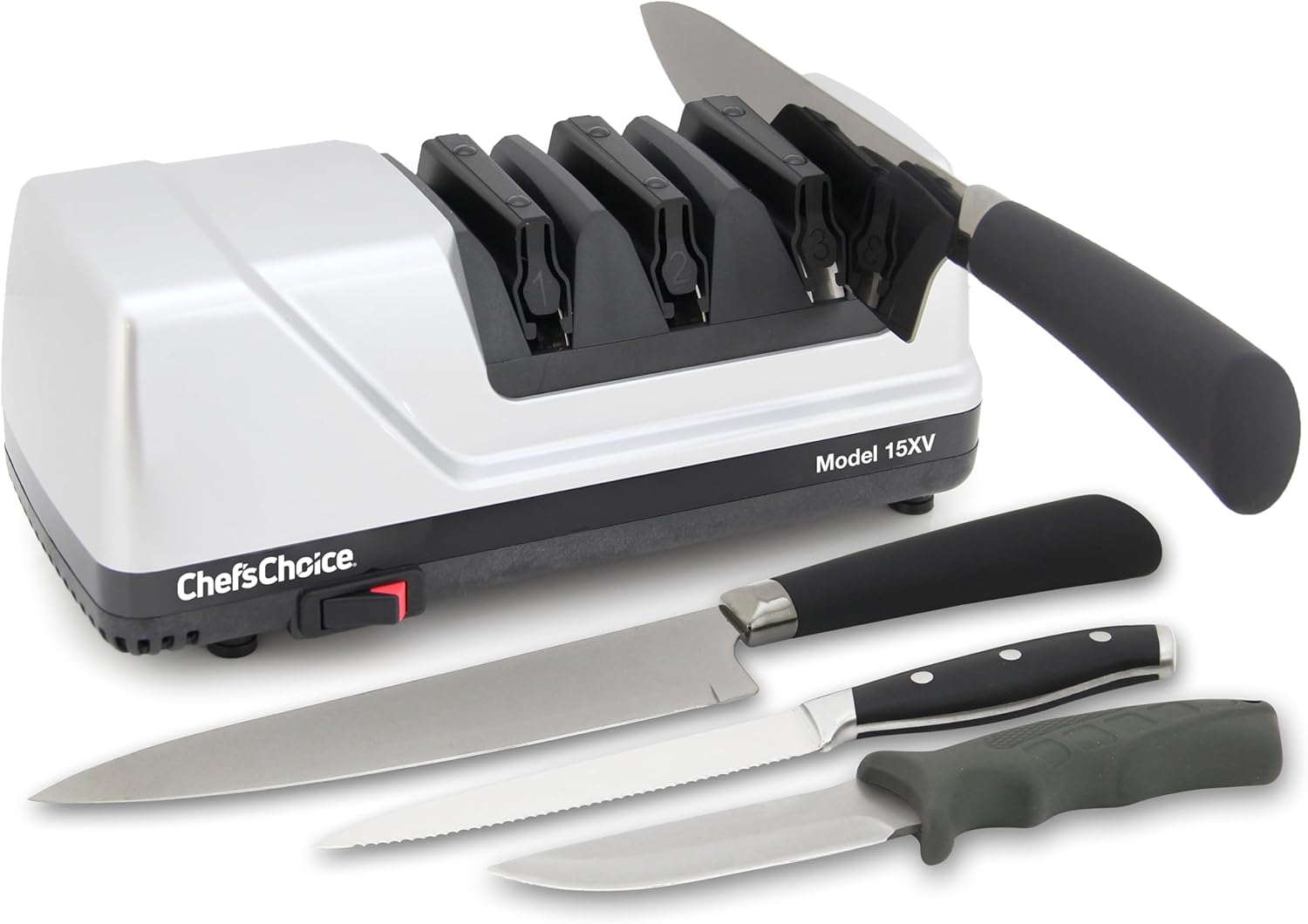 |
Electric | Best Overall Performance | View Price |
| Work Sharp Culinary E2 |  |
Electric | Best for Beginners | View Price |
| Sharp Pebble Whetstone Kit |  |
Whetstone | Best for Enthusiasts | View Price |
| Idahone Ceramic Honing Rod |  |
Honing Rod | Essential Daily Maintenance | View Price |
| Smith’s 2-Step Sharpener |  |
Manual | Best Budget Option | View Price |
In-Depth Reviews: The 5 Best Ways to Get a Sharp Edge
We ran dozens of dull knives through these sharpeners to see which ones delivered the best, most consistent results. Here’s how they stacked up.
1. Chef’sChoice Trizor XV Electric Sharpener (Best Overall)
This American-made machine is the gold standard in home electric sharpeners. Its key feature is its ability to convert a standard 20-degree factory edge (common on Western knives) into a high-performance 15-degree “Trizor” edge. This narrower angle makes knives feel significantly sharper. It uses a three-stage system: Stage 1 uses diamond abrasives for aggressive sharpening, Stage 2 uses finer diamond abrasives to refine the edge, and Stage 3 uses flexible stropping disks to polish it to hair-splitting sharpness.
The spring-loaded angle guides are foolproof, ensuring a perfect angle every time. It’s fast, effective, and can resurrect even the dullest, most neglected knives. For a serious home cook who owns high-quality knives—perhaps after reading our Wüsthof vs. Zwilling vs. Shun guide—this is a worthy investment to maintain them at peak performance.
Who is this best for?
The home cook who wants professional-level sharpness with maximum convenience and is willing to invest in a top-tier tool to protect their premium knives.
- Creates an incredibly sharp 15-degree edge
- Foolproof 3-stage system is easy to use
- Works on both straight and serrated knives
- Fast and highly effective
- Built to last for decades
Pros
- Significant investment
- Removes more metal than manual methods
Cons
2. Work Sharp Culinary E2 Electric Sharpener (Best for Beginners)
If the Chef’sChoice seems like overkill, the Work Sharp E2 is the perfect entry point into electric sharpeners. It’s compact, affordable, and incredibly simple. Unlike other sharpeners that use static grinding wheels, the E2 uses a flexible abrasive belt, just like the ones used to sharpen knives in the factory. This creates a “convex” edge, which is known to be stronger and more durable than a flat-ground edge.
There are no stages to worry about. You simply pull your knife through the single slot, and the machine does the rest, guided by a precise 20-degree angle. It also features a ceramic honing slot to touch up your blade between sharpenings. It’s gentle on knives and is perfect for maintaining the edge on the best affordable chef knives.
Who is this best for?
The everyday home cook who wants a fast, simple, and effective way to keep their knives sharp without a steep learning curve or high cost.
- Extremely easy to use
- Affordable for an electric model
- Flexible belt is gentle on knives
- Creates a strong convex edge
- Compact and easy to store
Pros
- Fixed 20-degree angle isn’t ideal for Japanese knives
- Not designed for serrated blades
Cons
3. Sharp Pebble Premium Whetstone Kit (Best for Enthusiasts)
For those who want complete control and the absolute sharpest possible edge, nothing beats a traditional whetstone (or water stone). This kit from Sharp Pebble is the perfect starting point. It includes a double-sided stone with a coarse 1000-grit side for sharpening and a fine 6000-grit side for polishing. It also comes with a non-slip bamboo base and, most importantly for beginners, a simple angle guide that helps you maintain the correct position.
There is a learning curve to using a whetstone, but the results are unparalleled. You can sharpen any knife to any angle you desire. It’s a meditative, rewarding process that connects you with your tools. Whether you’re trying to decide between a Victorinox vs. Zwilling, learning to use a whetstone will give you the skill to maintain either one perfectly for a lifetime.
Who is this best for?
The cooking enthusiast, DIY-er, or anyone who wants the ultimate control over their knife’s edge and enjoys a hands-on process.
- Provides the sharpest, most refined edge
- Gives you complete control over the angle
- Removes very little metal, extending knife life
- Can sharpen any blade, including scissors and tools
- Very affordable for the results it delivers
Pros
- Requires practice and patience to master
- Can be messy and time-consuming
Cons
4. Idahone 12-Inch Ceramic Honing Rod (Essential for Maintenance)
This is not a sharpener, and that’s a critical distinction. A honing rod is for daily or weekly maintenance. It realigns a blade’s edge, keeping a sharp knife sharp. We recommend a ceramic rod over a standard steel one because it is slightly abrasive and can perform very minor sharpening, making it more effective. This 12-inch rod from Idahone is a favorite among professional chefs for its high-quality ceramic and comfortable handle.
Using this rod before each use will dramatically extend the time between actual sharpenings. It’s arguably the most important sharpening tool you can own. Whether you own the best budget chef knife or a premium blade, regular honing is non-negotiable for good performance. Remember, once a knife is truly dull, a honing rod can’t bring it back—that’s when you need one of the other sharpeners on this list.
Who is this best for?
Every single person who owns a kitchen knife. This is an essential, non-negotiable tool for basic knife maintenance.
- Essential for maintaining a sharp edge
- Ceramic is more effective than steel
- Extends the life of your blade’s edge
- Easy and quick to use
- High-quality, made in the USA
Pros
- Does not sharpen a truly dull knife
- Can break if dropped
Cons
5. Smith’s 2-Step Knife Sharpener (Best Budget Option)
If you need a simple, cheap, and effective way to put an edge on a knife, this pull-through sharpener from Smith’s is a fantastic choice. It costs less than a fancy cup of coffee and is incredibly easy to use. It features two slots: a “Coarse” slot with carbide blades for setting the edge on a very dull knife, and a “Fine” slot with ceramic rods for honing and finishing the edge.
This type of sharpener is aggressive and removes a good amount of metal, so it’s not recommended for expensive, high-end Japanese knives. However, for reviving utility knives, pocket knives, or your everyday workhorse kitchen knife, its speed and simplicity are unmatched. It’s also small enough to throw in a drawer or a tackle box. It’s a great companion for a sturdy blade you might learn about in our Wüsthof vs. Victorinox article.
Who is this best for?
The cook on a tight budget, someone looking for a simple tool for their utility knives, or as a backup sharpener for a vacation home.
- Extremely affordable and compact
- Very simple two-step process
- Quickly sharpens very dull blades
- Non-slip base for safety
Pros
- Aggressive; removes a lot of metal
- Not suitable for high-end or Japanese knives
- Edge is not as refined as other methods
Cons
Your Sharpening Questions, Answered
What’s the difference between honing and sharpening?
This is the most important concept in knife care. Honing is maintenance. It uses a steel or ceramic rod to realign the blade’s microscopic edge, which gets wavy with use. It doesn’t remove steel. Think of it like combing your hair. Sharpening is repair. It grinds away steel to create a brand new, sharp edge. Think of it like getting a haircut. You should hone frequently (at least once a week) and sharpen infrequently (once or twice a year).
Are electric knife sharpeners bad for your knives?
Cheap, old-fashioned electric sharpeners got a bad reputation for eating up knives, but modern, high-quality models are very different. A good sharpener like the Chef’sChoice Trizor XV uses multi-stage, flexible abrasives that are much gentler. While they do remove more metal than a whetstone, they are safe for your knives when used as directed (i.e., not every week). They are an excellent choice for convenience and reliability.
What angle should I sharpen my knives to? 15 or 20 degrees?
It depends on your knife. 15-17 degrees (per side) is typical for Japanese knives from brands like Shun and Global. This acute angle is incredibly sharp but more delicate. 20 degrees (per side) is the standard for most Western knives from German brands like Wüsthof, Zwilling, and Henckels (see our Zwilling vs. Henckels comparison). This wider angle is more durable and better suited for heavy-duty work. The best practice is to sharpen your knife to its factory angle.
Can I sharpen a serrated bread knife?
Yes, but not with most standard sharpeners. Some electric models, like the Chef’sChoice, have a dedicated stage that polishes the serrations. To do it manually, you need a special tapered sharpening rod that fits into the individual gullets (the dips in the serrations). For most people, the serrations on a quality best bread knife will last for many years without needing sharpening.
The Final Verdict: The Sharpest Choice for Your Kitchen
A knife is only as good as its edge, and investing in a quality sharpening system is one of the most impactful upgrades you can make to your kitchen. After putting these tools to the test, our recommendations are designed to fit every type of cook.
For the ultimate combination of speed, convenience, and performance, the Chef’sChoice Trizor XV is the undisputed champion. It’s a serious tool that delivers professional results with foolproof consistency.
For the enthusiast who wants total control and the most refined edge possible, the Sharp Pebble Whetstone Kit provides everything you need to master the art of sharpening. And for an essential tool every single cook should own, the Idahone Ceramic Honing Rod is the key to day-to-day maintenance that keeps your knives sharper for longer.
Stop struggling with dull knives. Choose the right sharpener for your needs, and rediscover the joy of a blade that glides effortlessly through any task. Your fingers—and your food—will thank you.
